Strength in Differences: Why Diversity in Healthcare Is More Important Than Ever

When Forbes revealed the 500 best employers for diversity in 2024, 90 healthcare employers made the list: 36 health systems and 54 healthcare organizations.1 Promoting diversity can be advantageous across a variety of industries but taking the time to develop strategies to encourage diversity, equity, and inclusion (DEI) within healthcare specifically is incredibly important – perhaps now more than ever.
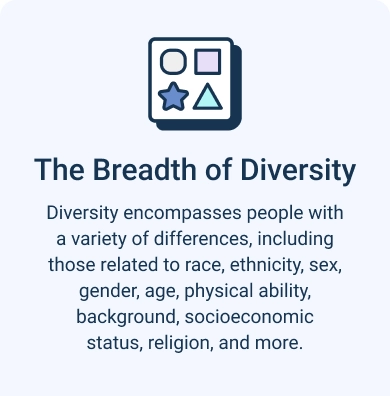

Importance of Diversity in Healthcare Today
Taking steps to promote DEI in the healthcare industry can provide several benefits for organizations, patients, and employees.
Closing Workforce Gaps
While progress is being made in terms of creating a more diverse healthcare workforce, the makeup of people working in these roles is still not representative of the general population.2 Developing a workplace culture that celebrates and encourages employees with a variety of experiences and who come from different backgrounds can help close this gap.
Improved Worker Retention
Creating a workplace that encourages diversity may even help draw in new talent. For example, one survey found that 53% of U.S. workers consider DEI a key factor when looking for employment, with this rate being even higher for Generation Z and Millennial job seekers at 77% and 63% respectively.3
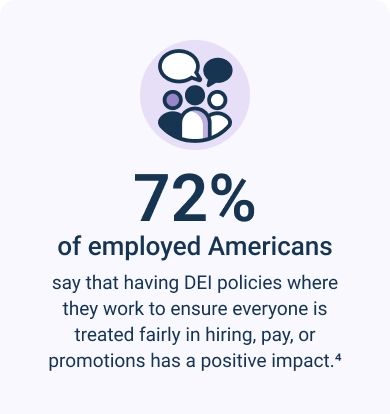

Better Patient Care
On March 26, 2024, ten of the top national healthcare and medical associations issued a joint statement in support of DEI’s role in high-quality patient care.5 Caring for the whole patient requires considering their health and how it may be impacted by system-wide inequities. It also involves making care accessible, enabling all patients the ability to address and manage their health-related needs.
Reduced Health Disparities
Not everyone faces health issues at the same rate. For example, African Americans and Latin Americans have a higher risk of developing cancer due to factors such as living in areas with more environmental pollution, greater exposure to socio-environmental stressors (such as racism), and the adoption of certain dietary and other behaviors.6 Finding ways to reduce these disparities can help promote the health of populations that are not currently adequately addressed.
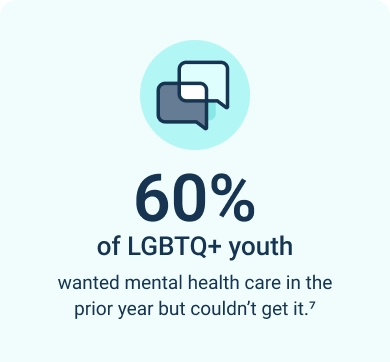

Increased Patient Comfort
Studies have shown that when patients share the same race as their healthcare providers, they feel more comfortable with these professionals and find it easier to build rapport.8 When patients are comfortable with their healthcare team, they may be more inclined to open up about the issues they face or the symptoms they are experiencing. This can help their providers better assess the situation and determine appropriate diagnosis and treatment options.
Benefits of Diverse Healthcare Leadership
Diversity in healthcare isn’t only about making all employees and patients feel welcome and included. It also involves prioritizing diversity within an organization’s leadership positions. This can provide several organizational advantages, including:
- Improved financial performance. Research involving 1,265 companies in 23 countries and six global regions found that when executive teams included women and/or were ethnically diverse, they had a 39% chance of financially outperforming companies that lacked this diversity.9
- Increased creativity. Individuals holding high-level healthcare roles are often tasked with finding unique ways to solve problems or coming up with new, innovative ways to get things done. Studies show that having a diverse leadership team boosts the team’s overall creativity, particularly when uncertainty exists.10
- Greater employee engagement. One study found that when leadership is oriented toward diversity, employees within minoritized groups perceive the organization to be more fair, which also increases their level of engagement.11 Engaged healthcare employees may not only feel more satisfied with their work, thereby being less likely to leave, but they also tend to have an enhanced focus on patient safety.12
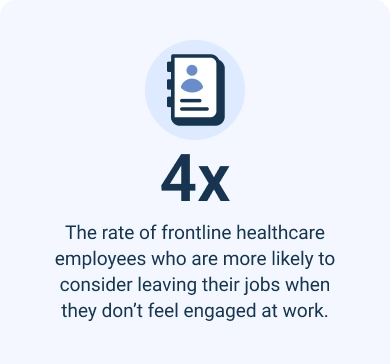

Next Step: Conducting a DEI Assessment
Once you recognize the numerous benefits of prioritizing DEI in the workforce, especially in today’s age, the next step is to develop a strategy that promotes a supportive and inclusive culture. This begins with conducting an assessment of your workplace as it stands today, highlighting areas where you excel as well as areas where you could improve.
The American Hospital Association provides several factors to consider when conducting your assessment, including:13
- Your current DEI efforts and strategies that are missing
- Your vision for what DEI means within the organization
- Data needed to measure DEI internally, as well as if you have access to this information
- Your goals related to DEI and the changes necessary to achieve them
Developing a DEI Strategy
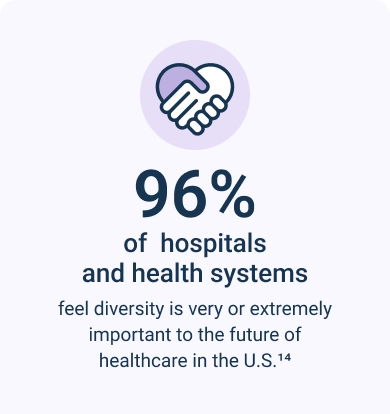

Findings from your assessment can be used to create an effective strategy for promoting DEI in your workplace. The Institute for Healthcare Improvement offers a framework for healthcare organizations when developing this strategy, and it consists of five basic key components:15
- Make health equity a priority.
- Establish processes that support health equity.
- Develop strategies to address determinants of health your organization can directly impact.
- Decrease institutional racism internally.
- Develop partnerships with other local organizations to further promote health equity.
Taking these steps can help you create a workplace that embraces DEI, also gaining the advantages of a diverse workforce.
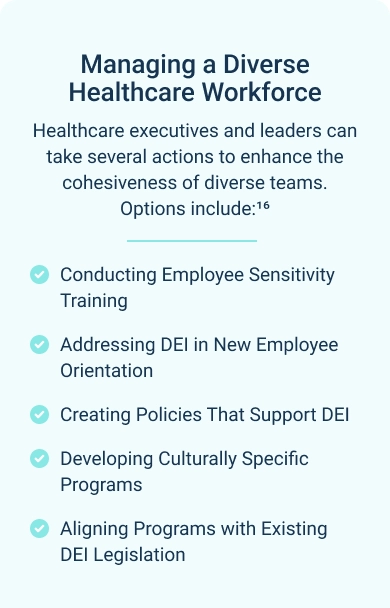
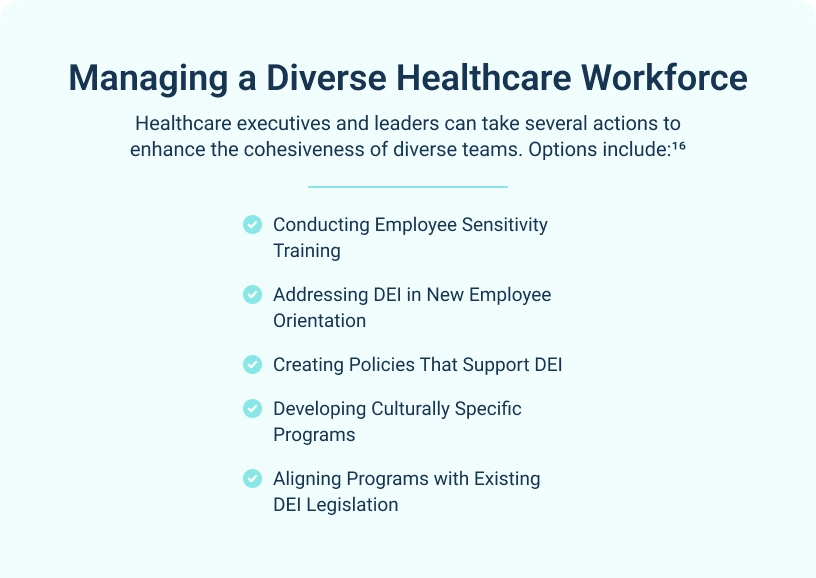
Focus on Diversity: Building a Healthcare Workforce for the Future
Diversity is an important topic in healthcare today, both in terms of creating equitable work opportunities and improving patient health. By taking action now, you can build a healthcare workforce that is fair and equitable today and tomorrow, offering current and future generations access to the careers and care they want, need, and deserve.
Nasium Training supports and celebrates people from all backgrounds. We offer allied healthcare upskilling and reskilling training options that help healthcare organizations enhance their workplace environment. Contact us today and let’s talk about the type of training that can take your employees – and organization – to the next level!
1 Advisory Board. The 90 best health care employers for diversity, according to Forbes. https://www.advisory.com/daily-briefing/2022/04/29/forbes-diversity
2 Majerczyk D, et al. Racial, Ethnic, and Sex Diversity Trends in Health Professions Programs from Applicants to Graduates. JAMA Network Open. https://jamanetwork.com/journals/jamanetworkopen/fullarticle/2813417
3 PR Newswire. More Than Half of Workers Say a Company’s DEI Efforts Are a Key Factor in Job Decisions According to New Eagle Hill Consulting Research. https://www.prnewswire.com/news-releases/more-than-half-of-workers-say-a-companys-dei-efforts-are-a-key-factor-in-job-decisions-according-to-new-eagle-hill-consulting-research-301919373.html
4 Minkin R. Diversity, Equity and Inclusion in the Workplace. Pew Research Center. https://www.pewresearch.org/social-trends/2023/05/17/diversity-equity-and-inclusion-in-the-workplace/
5 AAMC. Statement on Improving Health Through DEI. https://www.aamc.org/news/press-releases/statement-improving-health-through-dei
6 Zavala VA, et al. Cancer health disparities in racial/ethnic minorities in the United States. British J Cancer. https://www.nature.com/articles/s41416-020-01038-6
7 The Trevor Project: 2022 National Survey on LGBTQ Youth Mental Health. https://www.thetrevorproject.org/survey-2022/
8 Moore C, et al. “It’s Important to Work with People that Look Like Me”: Black Patients’ Preferences for Patient-Provider Race Concordance. J Racial Ethnic Health Disparities. https://link.springer.com/article/10.1007/s40615-022-01435-y
9 McKinsey & Company. Diversity Matters Even More: The Case for Holistic Impact. https://www.mckinsey.com/featured-insights/diversity-and-inclusion/diversity-matters-even-more-the-case-for-holistic-impact
10 Hundschell A, et al. The Effects of Diversity on Creativity: A literature review and synthesis. Applied Psychology. https://iaap-journals.onlinelibrary.wiley.com/doi/full/10.1111/apps.12365
11 Lee Y, et al. Diversity-Oriented Leadership, Internal Communication, and Employee Outcomes: A Perspective of Racial Minority Employees. J Public Relations Res. https://www.tandfonline.com/doi/abs/10.1080/1062726X.2021.2007388
12 Janes G, et al. The Association Between Health Care Staff Engagement and Patient Safety Outcomes: A Systematic Review and Meta-Analysis. J Patient Safety. the_association_between_health_care_staff.10.aspx
13 American Hospital Association. Strengthening the Health Care Workforce. https://www.aha.org/workforce-strategies/diversity-equity-inclusion
14 IFDHE. DEI Data Insights. https://ifdhe.aha.org/system/files/media/file/2023/11/ifdhe_dei-benchmark-survey-1-strategy.pdf
15 Institute for Healthcare Improvement. Achieving Health Equity: A Guide for Health Care Organizations. https://www.ihi.org/resources/white-papers/achieving-health-equity-guide-health-care-organizations
16 Zou Y. Improving Healthcare Workforce Diversity. Front Health Serv. https://www.ncbi.nlm.nih.gov/pmc/articles/PMC10012645/
